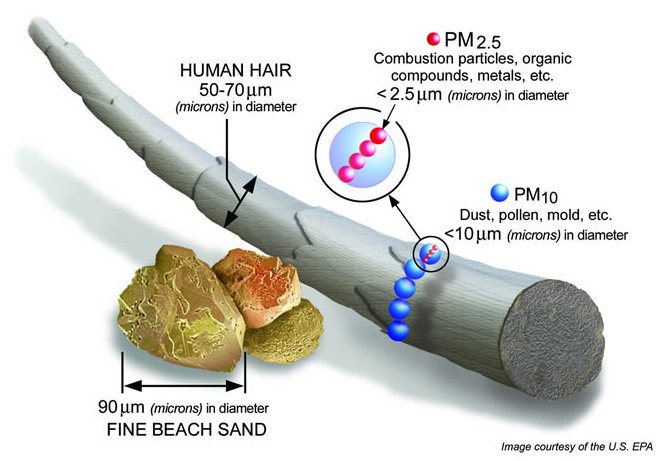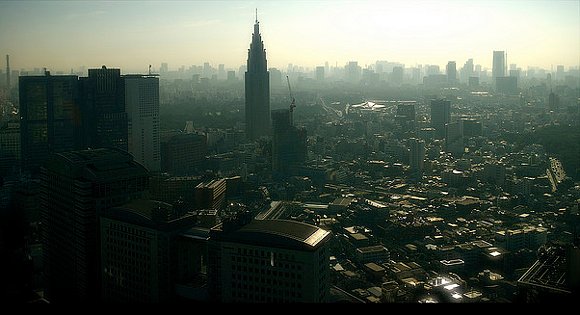PM2.5 refers to atmospheric particulate matter (PM) that have a diameter of less than 2.5 micrometers, which is about 3% the diameter of a human hair.
Commonly written as PM2.5, particles in this category are so small that they can only be detected with an electron microscope. They are even smaller than their counterparts PM10, which are particles that are 10 micrometres or less, and are also called fine particles.
Where Do PM2.5 Come From
Fine particles can come from various sources. They include power plants, motor vehicles, airplanes, residential wood burning, forest fires, agricultural burning, volcanic eruptions and dust storms.
Some are emitted directly into the air, while others are formed when gases and particles interact with one another in the atmosphere.
For instance, gaseous sulfur dioxide emitted from power plants reacts with oxygen and water droplets in the air to form sulfuric acid as a secondary particle.
Why Are PM2.5 Dangerous
Since they are so small and light, fine particles tend to stay longer in the air than heavier particles. This increases the chances of humans and animals inhaling them into the bodies. Owing to their minute size, particles smaller than 2.5 micrometers are able to bypass the nose and throat and penetrate deep into the lungs and some may even enter the circulatory system.
Studies have found a close link between exposure to fine particles and premature death from heart and lung disease. Fine particles are also known to trigger or worsen chronic disease such as asthma, heart attack, bronchitis and other respiratory problems.
A study published in the Journal of the American Medical Association suggests that long-term exposure to PM2.5 may lead to plaque deposits in arteries, causing vascular inflammation and a hardening of the arteries which can eventually lead to heart attack and stroke. Scientists in the study estimated that for every 10 micrograms per cubic meter (μg/m3) increase in fine particulate air pollution, there is an associated 4%, 6% and 8% increased risk of all-cause, cardiopulmonary and lung cancer mortality, respectively.
The American Heart Association has also warned about the impact of PM2.5 on heart health and mortality:
“Exposure to PM <2 .5="" diameter="" in="" m="" span="" style="border: 0px; bottom: -0.25em; font-size: 12.0005px; line-height: 0; margin: 0px; padding: 0px; position: relative; vertical-align: baseline;">2.5
over a few hours to weeks can trigger cardiovascular disease-related mortality and nonfatal events; longer-term exposure (eg, a few years) increases the risk for cardiovascular mortality to an even greater extent than exposures over a few days and reduces life expectancy within more highly exposed segments of the population by several months to a few years.”
An association between mothers’ exposure to fine particles and birth defects has also been established by several reports.
Children, older adults and those who are suffering from lung and/or heart disease are especially vulnerable to the adverse effects of fine particles in the air and should take special precautions when ambient PM2.5 crosses unhealthy levels.
How to Read PM2.5 Readings
Due to the many adverse effects fine particles can inflict on a large number of people, PM2.5 is one of the major pollutants closely monitored by health authorities around the world. You will most likely come across a dedicated column for PM2.5 alongside the Air Quality Index (AQI), Pollutants Standards Index (PSI) or the air quality standards adopted by your country.
On a very clear and non-hazy day, the PM2.5 concentration can be as low as 5 μg/m3 or below. The 24-hour concentration of PM2.5 is considered unhealthy when it rises above 35.4 μg/m3.
Why 24-hour and not a shorter duration when evaluating the health impact of fine particles? This is because the potential damage caused by air pollutants depends not just on the concentration, but also on the duration of exposure. The longer you are exposed to PM2.5, the higher the risk of developing adverse effects caused by the exposure. That’s why a 24-hour measurement is a better reflection of the health effects of fine particles than say a three-hour reading.
The table below will give you a sense of what levels of PM2.5 are harmful and the appropriate precautions you need to take. It is based on the air quality standards for particle pollution published by the U.S. Environmental Protection Agency.
24-Hour PM2.5 Levels (μg/m3)
PM2.5
|
Air Quality Index
|
PM2.5 Health Effects
|
Precautionary Actions
|
|---|
0 to 12.0
|
Good
0 to 50
| Little to no risk. | None. |
12.1 to 35.4
|
Moderate
51 to 100
| Unusually sensitive individuals may experience respiratory symptoms. | Unusually sensitive people should consider reducing prolonged or heavy exertion. |
35.5 to 55.4
|
Unhealthy for Sensitive Groups
101 to 150
| Increasing likelihood of respiratory symptoms in sensitive individuals, aggravation of heart or lung disease and premature mortality in persons with cardiopulmonary disease and the elderly. | People with respiratory or heart disease, the elderly and children should limit prolonged exertion. |
55.5 to 150.4
|
Unhealthy
151 to 200
| Increased aggravation of heart or lung disease and premature mortality in persons with cardiopulmonary disease and the elderly; increased respiratory effects in general population. | People with respiratory or heart disease, the elderly and children should avoid prolonged exertion; everyone else should limit prolonged exertion. |
150.5 to 250.4
|
Very Unhealthy
201 to 300
| Significant aggravation of heart or lung disease and premature mortality in persons with cardiopulmonary disease and the elderly; significant increase in respiratory effects in general population. | People with respiratory or heart disease, the elderly and children should avoid any outdoor activity; everyone else should avoid prolonged exertion. |
250.5 to 500.4
|
Hazardous
301 to 500
| Serious aggravation of heart or lung disease and premature mortality in persons with cardiopulmonary disease and the elderly; serious risk of respiratory effects in general population. | Everyone should avoid any outdoor exertion; people with respiratory or heart disease, the elderly and children should remain indoors. |
Source: U.S. Environmental Protection Agency
How to Protect Yourself Against PM2.5
When the amount of PM2.5 is at unhealthy level, take these steps to reduce exposure and protect your health:
- Stay indoor and close all windows and openings that allow polluted air to enter, when possible.
- Turn on an air purifier that is equipped with a HEPA filter. Only a HEPA filter can effectively remove fine particles from the air.
- Most air filters in air conditioners are not HEPA filters as the latter will reduce air intake and would require the motor to work harder to push / pull air through. But an air conditioner is still helpful when fresh air intake is limited as it helps to circulate air and cool down (or warm up) room temperature.
- When most or all windows are closed, do not burn candle, incense or operate devices that emit smoke or gas to prevent harmful particles and gas (such as carbon monoxide) from building up.
- If you are a road warrior who must drive in all weather conditions, get a real air purifier for your car that comes with at least HEPA and activated carbon filters. A normal car filter can’t even remove traffic exhaust properly, let alone microscopic particles.
- If the air pollution is expected to last for many days, consider moving to an unaffected location.
- Boost your body’s resistance against PM2.5 by increasing your intake of these nutrients.
- If you must go outdoor, make it short and quick, and wear a N95 or higher face mask.




